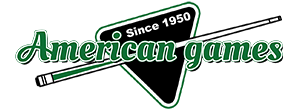Q. How big is the room in which I wish to place the table?
A. When choosing a pool table, there are several questions that you must first answer for yourself. These questions are geared to several different categories. The first thing that you must determine is what size table you wish to purchase. Sometimes, this will be decided by your room dimensions, and other times it may be decided by the intended use of your table. Although pool tables are commonly referred to as 4 x 8′ or 4 1/2 x 9′, the table itself will not measure those dimensions. Tables come in four different sizes;
Q. What size table do I have room for and what size table do I wish to own?
A.When deciding what size table to buy, most people will incorrectly want to know the outside measurements of the pool table. While there is nothing wrong with having this information, it is more important to consider the playing surface measurements. The reason for this is that the ball will never travel beyond this perimeter; therefore, your shots always come from within those dimensions. You then allow room around the playing surface for cue stick clearance. If you have room for your cue sticks, you will have plenty of room to walk and move around your new pool table.
Q. What considerations should I consider when buying a pool table?
A. For the kids to use? If you are buying the table mainly to entertain the kids, then the styling may not be as important as the quality. For the adults to use? If mainly the adults will use the table, then you may want the largest size available to you along with the fancier styling. As a piece of furniture for the home? If you are buying the table as a piece of furniture for your home, then obviously, you will want to get the most attractive table that your budget will allow. Your answer may actually be a combination of all three. That is OK; tailor your table to your own desires.
Q. What can you tell me about the slate of a pool table?
A. Slate can come in either a 1- piece section or a 3-piece set. 1-piece slate is very cumbersome and difficult to level because it covers such a large expanse of space. It is generally only 3/4″ in thickness and does not have any guarantees concerning the level. The most common place that 1 piece slate can be found is on 70s era or coin operated tables.
3-piece slate is the best type of slate because it allows for more precise leveling. With three different sections of slate, each can be leveled individually to achieve a perfect level. This, of course, will allow your table to play better. 3 piece slate is available in several different thickness including, 3/4″, 7/8″, and 1″.
Q. How thick is the slate?
A. This is one of the most important questions to ask about slate. The Billiard Congress of America (BCA) requires that the slate on tournament tables be 1″ thick and three pieces.
3/4″ slate, when in the 3 pc. configuration, is generally used to give the convenience of leveling and handling while keeping the cost of the table as low as possible. This slate is usually, but not always, used on less expensive tables.
7/8″ slate is often used as a substitute for true 1″ slate. It comes only in three pieces and it is hard for the untrained eye to tell the difference between 7/8″ and 1″. A table with this slate should be a little less expensive than a table with 1″ slate. This can also be a good indicator that a manufacturer is trying to save money on the construction of the table.
1″ thick slate is the only slate approved by the BCA for tournament use. It comes only in 3 pieces. It will provide the truest and most accurate play of any of the three slate thicknesses. Although it is only slightly more expensive than 7/8″, it is 12.5% heavier in total weight. It is important to note that the weight of the table will have direct impact on how true a ball rolls and rebounds.
Q.What style of pocket is used?
A. There are basically three types of pockets used in the industry today. Each is unique in the way that it mounts to the table. #6 and #3 pockets both have the pocket cover wrapped around a metal iron that forms the shape of the pocket. The #6 has pins that insert into the end of each rail. A bolt is then inserted from the underside of the rail to secure the pocket. The #3 has pins which usually flush mount to the top of the rail. Many antique tables have #3 pockets. Both of these style pockets are exposed to the eye when looking at the table. They actually form a joint, which connects the rails. Because of the shape of the iron, they will play better than other style pockets.
Enclosed pockets are the third type of pocket. It is totally enclosed within the rail system. The pocket is actually inserted within a cutout inside the rail. It is usually used on very inexpensive style tables, commercial style tables, or modem style tables. These pockets are generally made of plastic or rubber, but may be leather on more expensive tables.
Q. Anything else I should know before buying a pool table?
A. You are about to make a major purchase. You should assume that the table you purchase would last the rest of your life. Take the time to compare tables from several different manufacturers and be sure that you are getting the best quality table that your budget will allow. Armed with a little knowledge, you should be able to ask the right questions and make the best choice for yourself.
